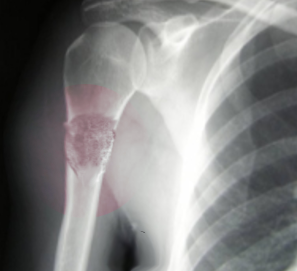[1]
Yarmish G,Klein MJ,Landa J,Lefkowitz RA,Hwang S, Imaging characteristics of primary osteosarcoma: nonconventional subtypes. Radiographics : a review publication of the Radiological Society of North America, Inc. 2010 Oct
[PubMed PMID: 21071381]
[3]
Turel MK,Joseph V,Singh V,Moses V,Rajshekhar V, Primary telangiectatic osteosarcoma of the cervical spine. Journal of neurosurgery. Spine. 2012 Apr
[PubMed PMID: 22225487]
[4]
Liu JJ,Liu S,Wang JG,Zhu W,Hua YQ,Sun W,Cai ZD, Telangiectatic osteosarcoma: a review of literature. OncoTargets and therapy. 2013
[PubMed PMID: 23745051]
[5]
Nishida J,Abe M,Shiraishi H,Shimamura T,Tamura G,Satoh T,Ehara S, Familial occurrence of telangiectatic osteosarcoma: cousin cases. Journal of pediatric orthopedics. 1994 Jan-Feb
[PubMed PMID: 8113361]
Level 3 (low-level) evidence
[6]
Mirra JM,Fain JS,Ward WG,Eckardt JJ,Eilber F,Rosen G, Extraskeletal telangiectatic osteosarcoma. Cancer. 1993 May 15;
[PubMed PMID: 8490830]
[7]
Murphey MD,wan Jaovisidha S,Temple HT,Gannon FH,Jelinek JS,Malawer MM, Telangiectatic osteosarcoma: radiologic-pathologic comparison. Radiology. 2003 Nov
[PubMed PMID: 14512511]
[8]
Huvos AG,Rosen G,Bretsky SS,Butler A, Telangiectatic osteogenic sarcoma: a clinicopathologic study of 124 patients. Cancer. 1982 Apr 15
[PubMed PMID: 6950802]
[9]
Ilaslan H,Sundaram M,Unni KK,Shives TC, Primary vertebral osteosarcoma: imaging findings. Radiology. 2004 Mar
[PubMed PMID: 14749514]
[10]
Roessner A,Hobik HP,Immenkamp M,Grundmann E, Ultrastructure of telangiectatic osteosarcoma. Journal of cancer research and clinical oncology. 1979 Oct
[PubMed PMID: 293331]
[11]
Metcalf DJ,Nightingale TD,Zenner HL,Lui-Roberts WW,Cutler DF, Formation and function of Weibel-Palade bodies. Journal of cell science. 2008 Jan 1
[PubMed PMID: 18096688]
[12]
Fletcher JA,Gebhardt MC,Kozakewich HP, Cytogenetic aberrations in osteosarcomas. Nonrandom deletions, rings, and double-minute chromosomes. Cancer genetics and cytogenetics. 1994 Oct
[PubMed PMID: 7923089]
[13]
Hoogerwerf WA,Hawkins AL,Perlman EJ,Griffin CA, Chromosome analysis of nine osteosarcomas. Genes, chromosomes & cancer. 1994 Feb
[PubMed PMID: 7513549]
[14]
Zielenska M,Marrano P,Thorner P,Pei J,Beheshti B,Ho M,Bayani J,Liu Y,Sun BC,Squire JA,Hao XS, High-resolution cDNA microarray CGH mapping of genomic imbalances in osteosarcoma using formalin-fixed paraffin-embedded tissue. Cytogenetic and genome research. 2004
[PubMed PMID: 15305059]
[15]
Weiss A,Khoury JD,Hoffer FA,Wu J,Billups CA,Heck RK,Quintana J,Poe D,Rao BN,Daw NC, Telangiectatic osteosarcoma: the St. Jude Children's Research Hospital's experience. Cancer. 2007 Apr 15
[PubMed PMID: 17351949]
[16]
Moore DD, Luu HH. Osteosarcoma. Cancer treatment and research. 2014:162():65-92. doi: 10.1007/978-3-319-07323-1_4. Epub
[PubMed PMID: 25070231]
[17]
Yin JQ,Fu YW,Xie XB,Cheng XY,Yang XY,Liu WH,Tu J,Gao ZH,Shen JN, Telangiectatic osteosarcoma: Outcome analyses and a diagnostic model for differentiation from aneurysmal bone cyst. Journal of bone oncology. 2018 Jun
[PubMed PMID: 29892520]
[18]
Papagelopoulos PJ,Mavrogenis AF,Savvidou OD,Benetos IS,Galanis EC,Soucacos PN, Pathological fractures in primary bone sarcomas. Injury. 2008 Apr;
[PubMed PMID: 18061185]
[19]
Kunze B,Bürkle S,Kluba T, Multifocal osteosarcoma in childhood. La Chirurgia degli organi di movimento. 2009 May;
[PubMed PMID: 19711159]
[20]
Zishan US,Pressney I,Khoo M,Saifuddin A, The differentiation between aneurysmal bone cyst and telangiectatic osteosarcoma: a clinical, radiographic and MRI study. Skeletal radiology. 2020 Sep;
[PubMed PMID: 32248448]
[21]
Zeitoun R,Shokry AM,Ahmed Khaleel S,Mogahed SM, Osteosarcoma subtypes: Magnetic resonance and quantitative diffusion weighted imaging criteria. Journal of the Egyptian National Cancer Institute. 2018 Mar;
[PubMed PMID: 29429892]
[22]
Angelini A,Mavrogenis AF,Trovarelli G,Ferrari S,Picci P,Ruggieri P, Telangiectatic osteosarcoma: a review of 87 cases. Journal of cancer research and clinical oncology. 2016 Oct
[PubMed PMID: 27469493]
Level 3 (low-level) evidence
[23]
Bacci G,Ferrari S,Ruggieri P,Biagini R,Fabbri N,Campanacci L,Bacchini P,Longhi A,Forni C,Bertoni F, Telangiectatic osteosarcoma of the extremity: neoadjuvant chemotherapy in 24 cases. Acta orthopaedica Scandinavica. 2001 Apr;
[PubMed PMID: 11372948]
Level 3 (low-level) evidence
[24]
Colomina J,Peiro A,Trullols L,Garcia I, Telangiectatic osteosarcoma. Journal of orthopaedic surgery (Hong Kong). 2013 Apr
[PubMed PMID: 23629998]
[25]
Basaran M,Bavbek ES,Saglam S,Eralp L,Sakar B,Atalar AC,Bilgic B,Ozger H,Onat H, A phase II study of cisplatin, ifosfamide and epirubicin combination chemotherapy in adults with nonmetastatic and extremity osteosarcomas. Oncology. 2007
[PubMed PMID: 18185020]
[26]
Kundu ZS. Classification, imaging, biopsy and staging of osteosarcoma. Indian journal of orthopaedics. 2014 May:48(3):238-46. doi: 10.4103/0019-5413.132491. Epub
[PubMed PMID: 24932027]
[27]
Sandberg AA,Bridge JA, Updates on the cytogenetics and molecular genetics of bone and soft tissue tumors: osteosarcoma and related tumors. Cancer genetics and cytogenetics. 2003 Aug;
[PubMed PMID: 12885459]
[28]
Khuu H,Moore D,Young S,Jaffe KA,Siegal GP, Examination of tumor and tumor-like conditions of bone. Annals of diagnostic pathology. 1999 Dec
[PubMed PMID: 10594288]

